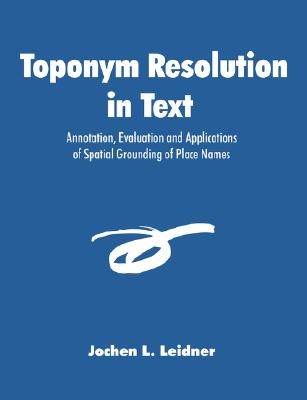
- We will send in 10–14 business days.
- Author: Jochen L Leidner
- Publisher: Dissertation.Com
- ISBN-10: 1581123841
- ISBN-13: 9781581123845
- Format: 18.9 x 24.6 x 1.6 cm, minkšti viršeliai
- Language: English
- SAVE -10% with code: EXTRA
Reviews
Description
The problem of automatic toponym resolution, or computing the mapping from occurrences of names for places as found in a text to an unambiguous spatial footprint of the location referred to, such as a geographic latitude/longitude centroid is difficult to automate due to insufficient and error-prone geographic databases, and a large degree of place name ambiguity: common words need to be distinguished from proper names (geo/non-geo ambiguity), and the mapping between names and locations is ambiguous (London can refer to the capital of the UK or to London, Ontario, Canada, or to about forty other Londons on earth). This thesis investigates how referentially ambiguous spatial named entities can be grounded, or resolved, with respect to an extensional coordinate model robustly on open-domain news text by collecting a repertoire of linguistic heuristics and extra-linguistic knowledge sources such as population. I then investigate how to combine these sources of evidence to obtain a superior method. Noise effects introduced by the named entity tagging that toponym resolution relies on are also studied. While few attempts have been made to solve toponym resolution, these were either not evaluated, or evaluation was done by manual inspection of system output instead of creating a re-usable reference corpus. A systematic comparison leads to an inventory of heuristics and other sources of evidence. In order to carry out a comparative evaluation procedure, an evaluation resource is required, so a reference gazetteer and an associated novel reference corpus with human-labelled referent annotation were created for this thesis, to be used to benchmark a selection of the reconstructed algorithms and a novel re-combination of the heuristics catalogued in the inventory. Performance of the same resolution algorithms is compared under different conditions, namely applying it to the output of human named entity annotation and automatic annotation using an existing Maximum Entropy sequence tagging model.
EXTRA 10 % discount with code: EXTRA
The promotion ends in 23d.01:23:52
The discount code is valid when purchasing from 10 €. Discounts do not stack.
- Author: Jochen L Leidner
- Publisher: Dissertation.Com
- ISBN-10: 1581123841
- ISBN-13: 9781581123845
- Format: 18.9 x 24.6 x 1.6 cm, minkšti viršeliai
- Language: English English
The problem of automatic toponym resolution, or computing the mapping from occurrences of names for places as found in a text to an unambiguous spatial footprint of the location referred to, such as a geographic latitude/longitude centroid is difficult to automate due to insufficient and error-prone geographic databases, and a large degree of place name ambiguity: common words need to be distinguished from proper names (geo/non-geo ambiguity), and the mapping between names and locations is ambiguous (London can refer to the capital of the UK or to London, Ontario, Canada, or to about forty other Londons on earth). This thesis investigates how referentially ambiguous spatial named entities can be grounded, or resolved, with respect to an extensional coordinate model robustly on open-domain news text by collecting a repertoire of linguistic heuristics and extra-linguistic knowledge sources such as population. I then investigate how to combine these sources of evidence to obtain a superior method. Noise effects introduced by the named entity tagging that toponym resolution relies on are also studied. While few attempts have been made to solve toponym resolution, these were either not evaluated, or evaluation was done by manual inspection of system output instead of creating a re-usable reference corpus. A systematic comparison leads to an inventory of heuristics and other sources of evidence. In order to carry out a comparative evaluation procedure, an evaluation resource is required, so a reference gazetteer and an associated novel reference corpus with human-labelled referent annotation were created for this thesis, to be used to benchmark a selection of the reconstructed algorithms and a novel re-combination of the heuristics catalogued in the inventory. Performance of the same resolution algorithms is compared under different conditions, namely applying it to the output of human named entity annotation and automatic annotation using an existing Maximum Entropy sequence tagging model.


Reviews